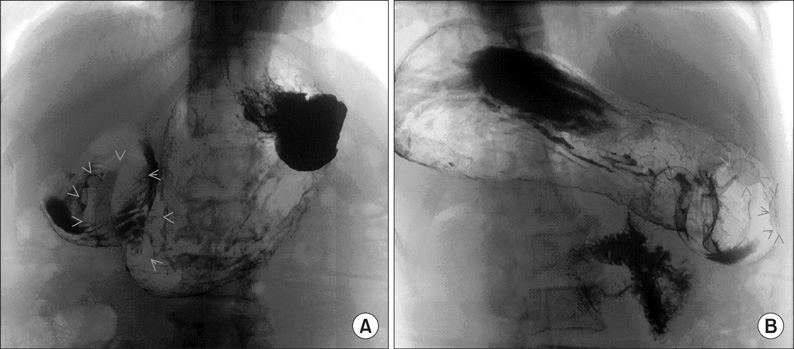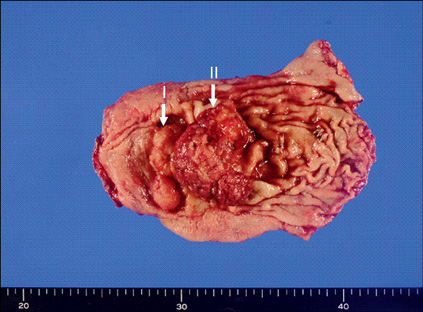J Korean Surg Soc.
2011 Dec;81(6):419-422. 10.4174/jkss.2011.81.6.419.
Adenocarcinoma derived from gastric hamartomatous polyps
- Affiliations
-
- 1Department of Surgery, Samsung Medical Center, Sungkyunkwan University School of Medicine, Seoul, Korea. jmoon.bae@samsung.com
- 2Department of Pathology, Samsung Medica Center, Sungkyunkwan University School of Medicine, Seoul, Korea.
- KMID: 1445772
- DOI: http://doi.org/10.4174/jkss.2011.81.6.419
Abstract
- Most hamartomatous polyps in the stomach occur in patients with adenomatous polyposis coli and dysplasia. The authors report a case of a 57-year-old man without prior history of polyposis coli who presented with adenocarcinomas derived from hamartomatous polyps in the stomach. The patient underwent a radical subtotal gastrectomy with Billroth I anastomosis. Pathology revealed adenocarcinomas with moderate differentiation without evidence of lymph node metastasis in 60 nodes. We report a case of gastric cancers arising from de novo gastric hamartomatous polyps.
Keyword
MeSH Terms
Figure
Reference
-
1. Jeghers H, McKusick VA, Katz KH. Generalized intestinal polyposis and melanin spots of the oral mucosa, lips and digits; a syndrome of diagnostic significance. N Engl J Med. 1949. 241:993. illust; passim.2. Giardiello FM, Welsh SB, Hamilton SR, Offerhaus GJ, Gittelsohn AM, Booker SV, et al. Increased risk of cancer in the Peutz-Jeghers syndrome. N Engl J Med. 1987. 316:1511–1514.3. Giardiello FM, Brensinger JD, Tersmette AC, Goodman SN, Petersen GM, Booker SV, et al. Very high risk of cancer in familial Peutz-Jeghers syndrome. Gastroenterology. 2000. 119:1447–1453.4. Hizawa K, Iida M, Matsumoto T, Kohrogi N, Kinoshita H, Yao T, et al. Cancer in Peutz-Jeghers syndrome. Cancer. 1993. 72:2777–2781.5. Hearle N, Schumacher V, Menko FH, Olschwang S, Boardman LA, Gille JJ, et al. Frequency and spectrum of cancers in the Peutz-Jeghers syndrome. Clin Cancer Res. 2006. 12:3209–3215.6. Park do Y, Lauwers GY. Gastric polyps: classification and management. Arch Pathol Lab Med. 2008. 132:633–640.7. Tatsuta M, Okuda S, Tamura H, Taniguchi H. Gastric hamartomatous polyps in the absence of familial polyposis coli. Cancer. 1980. 45:818–823.8. Flageole H, Raptis S, Trudel JL, Lough JO. Progression toward malignancy of hamartomas in a patient with Peutz-Jeghers syndrome: case report and literature review. Can J Surg. 1994. 37:231–236.9. Bertoni G, Sassatelli R, Nigrisoli E, Pennazio M, Tansini P, Arrigoni A, et al. Dysplastic changes in gastric fundic gland polyps of patients with familial adenomatous polyposis. Ital J Gastroenterol Hepatol. 1999. 31:192–197.10. Attard TM, Giardiello FM, Argani P, Cuffari C. Fundic gland polyposis with high-grade dysplasia in a child with attenuated familial adenomatous polyposis and familial gastric cancer. J Pediatr Gastroenterol Nutr. 2001. 32:215–218.
- Full Text Links
- Actions
-
Cited
- CITED
-
- Close
- Share
- Similar articles
-
- Four Cases of Gastric Hamartomatous Polyps without Polyposis Coli
- Hamartomatous gastric polyposis in a patient with tuberous sclerosis
- Successful Treatment of Gastric Hamartomatous Polyp with Hemorrhage by Endoscopic Mucosal Resection
- Adenocarcinoma Occurring in a Gastric Hyperplastic Polyp Treated with Endoscopic Submucosal Dissection
- A Case of Adenocarcinoma Arising from a Hyperplastic Polyp in the Stomach





